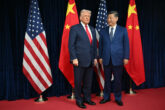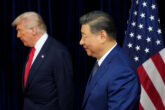June 10, 2024
Obama tried to pivot to Asia in 2011. We must succeed this time.
This article, originally published in The Washington Post, is an excerpt from Lost Decade: The US Pivot to Asia and the Rise of Chinese Power.
In 2011, President Barack Obama announced that the United States would, after centuries of preoccupation with Europe and decades of Middle East wars, put the Asia-Pacific region first. Washington would increase its military presence there, step up diplomacy, secure a regionwide trade deal and more.
Pivoting — or rebalancing — to Asia quickly won support among policymakers in both parties and across subsequent administrations. It coupled sound strategic logic with a keen appreciation of the ways in which the world was changing. By engaging more deeply with the region, the United States could better reap its economic promise and more effectively deal with a rising China.
China’s unique combination of power and determination to upend global order represents a generational challenge for American policymakers.
It was easier said than done. The United States established new basing and porting arrangements in the Asia-Pacific region, invested in new systems and research and development, and forged new defense relationships, all to the good. Yet in 2022, Washington had more troops in Europe than it did in 2011. High-end systems deployed routinely to the Middle East and not to Asia. And during this entire period, Chinese military power grew at an astonishing clip. The result has been a dramatic deterioration in the Asia-Pacific military balance away from the United States and its allies.
Meanwhile, China stepped up its diplomacy, forged new partnerships and increased its global engagement as U.S. attention wandered, depending on events and policymakers’ personal preferences. The Trans-Pacific Partnership, a 12-member trade agreement that was once a central economic initiative, crashed on the rocks of domestic political opposition. As President Donald Trump withdrew from the TPP, China emerged as the top trading partner of nearly every nation across the region.
Throughout the Obama and Trump years, the result was a lost decade in responding to China’s rise. Even if the pivot had been executed as intended, the United States would today still face a momentous challenge from China. But it would be far better prepared to take it on.
Read the full article from The Washington Post.
More from CNAS
-
Chinese Maker of Bitcoin-Mining Machines Is a Security Threat, Says Expert
Bloomberg News reports that a Chinese manufacturer, Bitmain Technologies Ltd, that sells most of the world’s Bitcoin-mining machines — including 16,000 of them to a venture ba...
By David Feith
-
Indo-Pacific Security / Energy, Economics & Security
North Korea’s Provocations, Power Plays, and Shifting AlliancesTensions on the Korean Peninsula have reached a new and dangerous threshold. President Lee Jae Myung is warning of a real risk of accidental military clashes, as the situation...
By Dr. Go Myong-Hyun
-
Indo-Pacific Security / Energy, Economics & Security
How to Win the Economic War with ChinaTrump's approach to China has run aground, giving Beijing unprecedented advantage in the economic conflict....
By Edward Fishman & Julian Gewirtz
-
Indo-Pacific Security / Technology & National Security
Sharper: Tech + ChinaRecent talks between President Donald Trump and Chinese Communist Party General Secretary Xi Jinping placed a spotlight on emerging technologies, from high-end chips to minera...
By Charles Horn & Sevi Silvia




